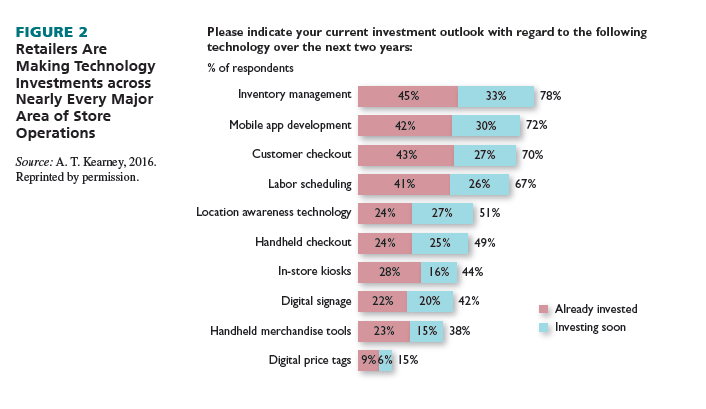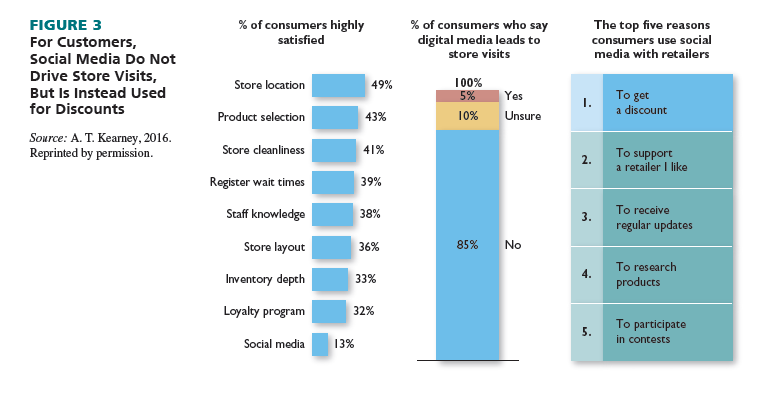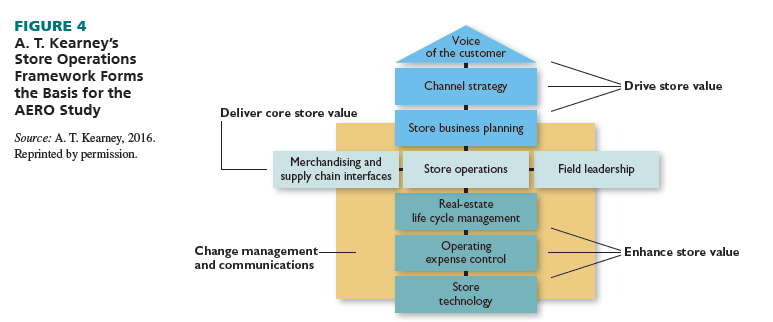1. Introduction
The 2016 A. T. Kearney Achieving Excellence in Retail Operations (AERO) study uncovers both the good and the bad in this new era of store operations. The good: a clear and consistent trend of “smarter” retail. Survey responses from executives at more than 100 global retailers reveal that companies are aligning store operations strategies and metrics to the new omnichannel environment and are investing heavily in providing support. Pilots and trials are evolving more rapidly and more fulfillment options are quickly becoming available across all retail sectors.
The bad: AERO points to the many challenges retailers face in effectively adopting these smarter strategies and metrics. Although technology is the number-one retail investment today, there’s limited visibility on the return on investment. Amid the noise of technology investment and omnichannel integration, store associates are often overlooked as crucial conduits for improved store performance. And importantly, the study points to a misalignment between consumer expectations and retailer offerings, with retailers investing in services that customers may not want, need, or expect, particularly in terms of fulfillment, in-store technology, and social engagement. In seeking to be all things to all people, are retailers driving unnecessary cost and complexity in their operations?
The 2016 AERO study probes these key trends in retail today, offers insightful case studies, and shares our thoughts on potential solutions By understanding the new rules of the game, improved retail operations can be a path to success in this new retail era.
2. A Smarter Way to Manage Retail Operations
Omnichannel has ushered in the next wave of growth in retail. But defining what it exactly is depends on who you’re talking to. Is it uniform messaging across channels? Seamless fulfillment across channels? Consistent pricing across channels? All of the above? Regardless of how it is defined, any retailer will tell you that its impact on retail operations has been incredible.
The AERO findings point to major changes already in place in stores to support omnichannel. Eighty-six percent of retailers have aligned store strategies and metrics to support an omnichannel environment. Store associates are being trained on cross-platform engagement, incentivized to sell through E-commerce channels, and rewarded for in-store fulfillment.
Training on consumer engagement, education, and sales is evolving as retail leaders rethink their stores’ role into showrooms, mini-distribution centers, education centers, and the like. Gone are the days when a store’s success was based solely on the revenue generated within the four walls, with store profit and incentive structures refined to include its surrounding E-commerce business. This has also fundamentally changed how store associates need to think about their customers.
Retailers are also getting smarter about when, where, and how they test their new concepts in stores. In our 2013 survey, we found that 19 percent of retailers had an active pilot program; today, the number is above 30 percent. This year’s survey finds some retailers are well down the path to a store operations toolset to be successful.
JOHN LEWIS CASE STUDY John Lewis, a 150-year-old U.K. department store, found a smarter way to manage technology and ultimately provide a differentiated service offering to consumers. The success started with several pilot programs. It used online technologies to pilot an “omnichannel store” that offered the full assortment of John Lewis products in a smaller format. Its app gave consumers access to 250,000 products, product reviews, price matches, wish lists, and videos. In-store iPads and computers gave consumers access to thousands of products not currently in the store, along with fulfillment options to a home or a store. And a click-and-collect program allowed customers to buy a range of products from John Lewis and other subsidiary brands, from clothing to homewares, online and then collect in one trip.
John Lewis’ offering has proved successful. Today, one- third of sales are from online purchases, worth roughly $1.5 billion, with growth in that channel of 25 percent. Its click- and-collect orders have reached 6 million per year, a 17-fold increase from 350,000 in 2008, its first year.
3. Aligning Consumer Expectations and Retailer Offerings
Despite the wave of exciting activity to support omnichannel, many bets that retailers are placing in store operations aren’t necessarily bringing desired results. Our study points to misalignment between retail offerings and consumer expectations. As retailers take leaps forward toward “omnichannel nirvana,” consumers are only demanding small steps.
While we expect expectations to shift as more options become available and known, the findings point to the need for simply getting this basic capability right; more than a third of respondents say their company falls short.
For example, we’ve also seen the race to near immediate shipping times—from next-day to same-day to one-hour shipping. Despite this focus, more than three-quarters of consumers surveyed say they merely expect two days or more for shipping. Consumers say they are more interested in retailers fulfilling their promises—getting products when they were told they would—rather than on getting the product immediately. See Figure 1.

These issues have dramatic implications on retail opera- tions—the need for new capabilities, skill sets, and tools, and for workflow and incentives to meet omnichannel expectations. The missed opportunity is when a retailer’s offering and the investments needed to produce it are far separated from customer expectations. What consumers value should underpin omnichannel investments in store operations—and not merely a retailer’s “omnichannel vision.” This will help avoid unnecessary cost and complexity, and ultimately reduce consumer confusion.
This year’s study finds once again that retailers are investing heavily in technology, yet are still struggling with figuring out its value. Technology is the number-one area of investment according to respondents in our 2016 study, with nearly every respondent saying they will invest in it. Yet nearly 60 percent surveyed say their company struggles with executing and measuring its return on investment. These results are slightly better than the findings in 2013, yet still quite low. See Figure 2.

So what’s going on here? Why are retailers continuing year after year to toss money at technology in an effort to chase after the next big thing in retail, yet coming up short?
We believe the answer lies with the focus of these investments. Ninety percent or so of retail sales still happen within the four walls of a physical store. Yet almost none of the investments we see today are about helping store associates do their jobs better. Instead, most focus on consumer-facing technology, even though 80 percent of consumers say they experience poor service when directly interacting with in-store technology. Just because there is a poor service experience today doesn’t mean to stop trying. Focusing investments on tools and information that enable the employee to better engage with customers and meet true customer needs will remain valuable. There is an opportunity to close the information gap regarding in-store customer interactions (such as preferences based on in-store activities), but that will require a greater sense of trust and willingness to share information than we have today.
The retailers that are investing in technology are successfully using it to help store associates. It helps ease the burden of execution also, as associates are incentivized to learn, adopt, and implement new technology solutions to boost productivity, sales, and potentially their own commissions.
4. Social Currency
Another focus area in the age of omnichannel is social media, and the value retailers can generate from getting it right. The 2016 survey, however, reveals a gulf between what the
consumers actually expect and what retailers are offering on social media. More than 60 percent of retailers say they still focus on mining social media to generate value. Two-thirds of consumers, on the other hand, say they are not engaging with retailers on social media at all; for those that do, the primary reason is to get a coupon or a discount. See Figure 3.

Is this another case of misalignment between the retailer’s offering and consumer expectations? Consider that more than 85 percent of consumers say that social-media interactions do not lead to store visits; and when asked to rank a number of touch points with retailers, consumers ranked social media the least valuable out of 13 listed. Store location, product selection, and store cleanliness topped the list.
This does not mean that retailers should stop investing so much time and effort in social media. Rather, they must refocus on doing it right. Retailers that have pulled ahead of the pack when it comes to social media engagement and the value they’re generating from it are interacting with customers online and creating a sense of community.
WARBY PARKER CASE STUDY Warby Parker’s eyeglass customers are more highly engaged on social media than those of typical retailers. Its strong social mission makes it popular with the younger population. The company also maintains a consistent, recognizable look across eyewear, Web site content, and store experience.
It succeeds in its social mission by regularly promoting unique and exclusive events that are apt to be shared on social media. It encourages interfacing with social media over the “try-on” period. Its #warbyhometryon hashtag gives the company an “expert” opinion of what its customers think of their eyewear.
5. Store Associates: The Unsung Heroes of Retail
So much focus today is on the consumer of the future, on new and exciting technologies, and on social media engagement, but the AERO findings show that the real heroes of store operations are in-store associates, and they are often being overlooked. Customers say that experience and service have the greatest impact on productivity. Yet we consistently find that store associates get little investment focus.
Nearly one-half of retailer respondents said employee training programs could be “significantly improved.” More than 70 percent of retailers expect spans of control to widen in the immediate future. And nearly all express concern regarding their workforce’s ability to adapt to a new omnichannel environment. In our opinion, it’s not that retailers have had store associates with poor skill sets, but rather that they have not had the right focus on what it takes to properly support in-store staff.
Store associates are the most important assets retailers have; they are central to the future of any store. Investments should focus on the core fundamentals of what it takes to support store associates: training, incentives, career progression, and corporate support to meet expectations. Interestingly, about labor; but right now, the workforce needs more support to do its most critical task: deliver superior customer service.
6. Driving to “Smarter” Retail
With the omnichannel age here, retailers are rapidly evolving store operations capabilities to support. How do you know if your retail organization is ready to realize its full value?
- Do you have a defined business strategy linking metrics across channels and store formats?
- Do you use learning stores and pilots for trying out change programs to understand the impact of your omnichannel investments?
- How well are you measuring the return on investment (ROI) for your retail technology expenditures?
- Are your online order delivery service levels aligned to effectively deliver to your customer when promised?
- How can you drive more value for you and your customers from social media?
- How are you investing in your in-store associates to set them up for success?
The truth is, many retailers are starting to answer these questions affirmatively. New strategies are seeking to meet consumer expectations, new metrics are more properly measuring and incentivizing store staff, and focused and more frequent store pilots are getting answers faster.
However, in their chase for “omnichannel nirvana,” retailers need to get better at the basics of omnichanne—a dedicated focus on what the customer wants and needs; support to ensure that investments improve store performance; clear reviews about returns on investment; and an understanding of how in-store associates can be supported. Retail remains a people business. Getting that part right remains a critical ingredient for success.
7. Research Methodology
ABOUT THE STUDY A. T. Kearney’s Achieving Excellence in Retail Operations (AERO) study provides insights into how
retailers globally can improve their operations. This year’s study captured more than 100 responses from senior retail executives in the Americas, Europe, and Asia Pacific, offering a view of emerging global best practices in store operations. It covers multiple sectors, including apparel, health and personal care, mass- market and hypermarket, electronics, food and grocery, and cash and carry.
Besides the retailer perspective, this year’s study also brings in the consumer view. We surveyed nearly 800 North American consumers across demographic backgrounds, and their responses provide a clear view of the consumer’s opinion of store operations. In the study, we compare and contrast retailer perspectives with those of consumers, identifying what is truly important to today’s retail environment.
The study is based on A. T. Kearney’s Store Operations Framework; see Figure 4. This framework, which was also used to pioneer the 2010 study, evaluates operations across setting strategic direction, delivering core value, optimizing expenses, and driving lasting change.

Source: Barry Berman, Joel R Evans, Patrali Chatterjee (2017), Retail Management: A Strategic Approach, Pearson; 13th edition.

28 May 2021
28 May 2021
27 May 2021
28 May 2021
28 May 2021
28 May 2021